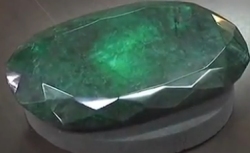
January Editorial
The world’s largest cut emerald - or is it?

January Editorial
The world’s largest cut emerald - or is it?
|
|
On January 17 2012 the news broke that the world’s largest cut emerald was to be auctioned in Kelowna, in British Columbia, Canada. The emerald, weighing 11.5 kg, was set to be auctioned at 1 pm on January 28 at Western Star Auctions. The present owner of this massive stone is Calgary rare gem dealer Regan Reaney. He claims that his 57,500-carat emerald is worth at least $1.15 million. |
|
|
You can see the emerald displayed by its proud owner in this video: The emerald is named 'Teodora' which means roughly 'God's Gift'. It was mined in Brazil and cut in India, and was only recently purchased by Mr Reaney. Premier Gems in Calgary has authenticated the stone. But no sooner had the news spread, than many gem experts voiced their doubts as to the authenticity of the stone. The major criticism is that this massive gemstone has been ‘enhanced’ and an undisclosed amount of dye has been added to it. For more precise details see here Emeralds are difficult stones to authenticate and value because it is so easy to tamper with them. Emerald is actually a variety of the mineral beryl (Be3Al2(SiO3)6). The distinctive green colouration which makes an emerald is caused by the presence of trace amounts of chromium and (sometimes) vanadium. White beryl is both common and relatively worthless. The most valuable emeralds are a transparent variety of beryllium aluminosilicate which contain small amounts of chromic oxide which give the stone its brilliant green colour. Large flawless stones are very rare because emeralds are brittle and most have impurities (known as inclusions). To conceal these microfissures and so improve their appearance, emeralds are usually treated with polymers or colourless oil which fills the microfissures and renders them invisible. (A rough analogy is how the garage fixes the cracks in a car windshield.) The important question for experts who authenticate emeralds is to determine when a gem is an emerald and when it is beryl (bearing in mind that emeralds are hundreds or thousands of times more valuable than beryl.) The critical aspect is the colour. The primary colour has to be green and the tone must be medium to dark. (Light-toned gems are known instead by the generic name of green beryl.) In addition, the hue of an emerald must be bright (or 'vivid'). We have seen that many emeralds are treated with colorless oils as part of the lapidary process. This improves the clarity of the stone. This treatment is legitimate and largely accepted by the gem trade, although the US Federal Trade commission requires the full disclosure of what has been done to the stone. However, other treatments are unacceptable - such as the use of green-tinted oil to enhance both colour and clarity. Unfortunately, it is very easy to make the colour of an ‘emerald’ deeper and darker by the judicious use of green dye. Many so-called ‘emeralds’ are artificial creations from enhanced green beryl. Indeed, even white beryl can be dyed any colour and intensity of green to create a totally fake stone. Without detailed chemical analysis (which damages the sample taken from the stone) is not easy to determine either that dye has been added or how much. Recently the scientific community of emerald experts standardized the language used in grading the clarity of emeralds. This scale refers to any artificial enhancement of the stone and not to its natural clarity. Gems are graded from four to none. None (0) means a completely natural emerald, while grade three (3) means ‘highly enhanced’. The vast majority of emeralds undergo a certain amount of treatment and two stones identical to the eye may actually be far apart in treatment levels and therefore in value. All else being equal, a high-quality emerald graded as 'moderate' (2) will cost about half as much as a stone with grade 'none'. Although not strictly allowed, the addition of green dye to the stone happens frequently and creates a further headache. With modern laboratory techniques any treatment and the extent of enhancement can be tested. A good gem laboratory can even determine which mine an emerald comes from. So anyone buying a really expensive emerald is well- advised to ask for a detailed laboratory analysis from a top-rated laboratory. The most highly regarded laboratories are with the Gemological Institute of America (GIA); established in 1931. This non-profit institute focuses mainly on research and education in the field of gemology, but it also offers gem-testing services. Colombia produces 55 per cent of the world’s emeralds with an annual export of around 200 million American dollars. The finest emeralds come from here, as does the largest emerald crystal (7,025 carats) ever discovered. (An emerald can consist of several crystals). 'Fura', a 15,000 carat emerald which is still kept uncut in its original form was also mined in Columbia. It was found 12 years ago in Boyaca, about 75 km (47 miles) north of Bogota. Other emerald-rich mines can be found in Zambia, Brazil, Madagascar, Russia, India and Pakistan. By some reports, the largest uncut emerald ever was found in 1974 in Carnaiba in Brazil. The stone was an incredible 86,136 carats and was valued at $1,120, 080. It eventually ended up in Hong Kong carved into a sculpture just over half the size of the original stone. | |
| _______________________________ | ||||
| Home | | | Shopping | | | Database |
© Biscuit Software 2004-2015
All rights reserved